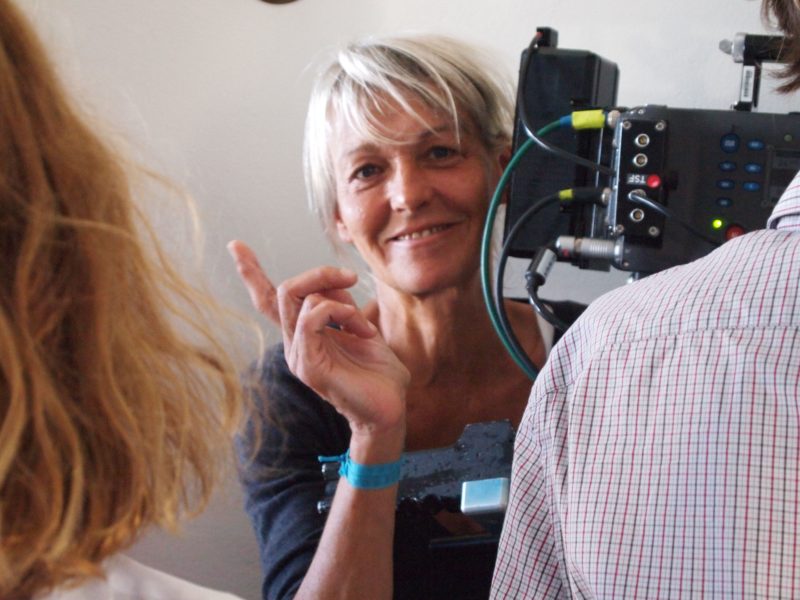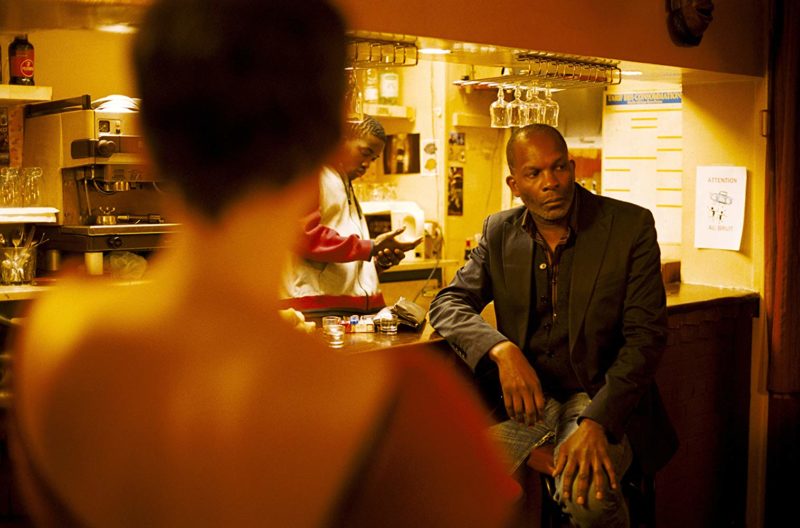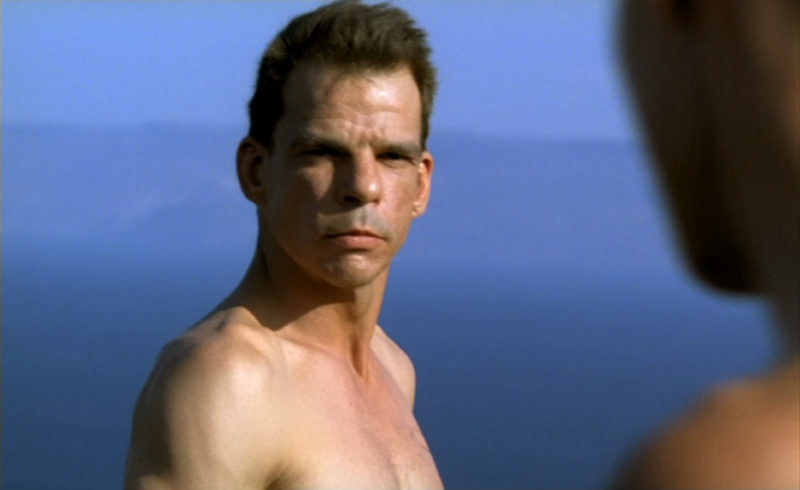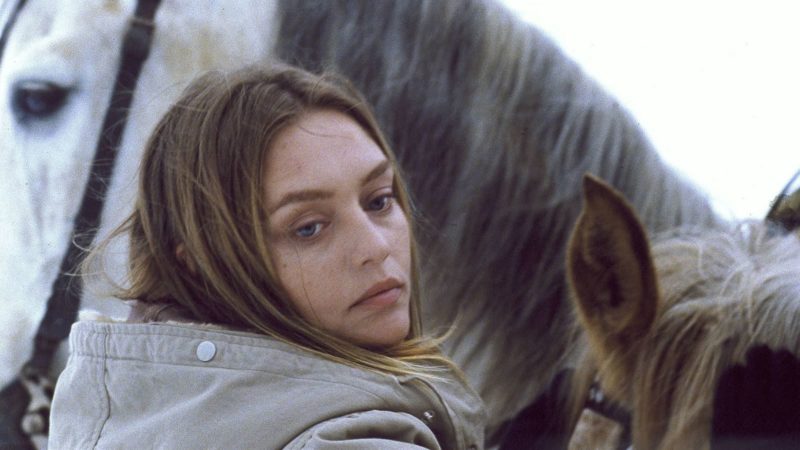Celebrated for the distinctly evocative, magnetic visuals she has crafted throughout her three-decade collaboration with Claire Denis, Agnès Godard practices cinematography as an alchemical art of transformation that combines rigor, immediacy, and transcendence. Freshly returned from New York, where she was a guest of honor at the Film Society of Lincoln Center’s series The Female Gaze, which runs through August 9, presenting three of her films with Denis—Beau Travail (1999), The Intruder (2004), and 35 Shots of Rum (2008)—Godard welcomed me into her Parisian artist’s loft (a former boilermaking factory) for a conversation about the evolution of her craft and her primal, symbiotic relationship with the camera that echoed the sensitivity and soulfulness of her images. As analysis gave way to contemplation, the gently serene room was enlivened by passionate reenactments of Denis’s cinema, complete with its indelible moods, sounds, colors, and textures. Over-the-shoulder camera is an essential motif of the raw aesthetic you and Claire have inaugurated with the frenetic and immersive No Fear, No Die [1990], but your latest film together, Let the Sunshine In [2017], consists entirely of tripod and dolly shots. How did you go about injecting the intimacy, sensuality, and spontaneity of your over-the-shoulder work into this more poised approach to probing a character’s interiority? It’s true that it was a change not to be doing over-the-shoulder, but it’s connected to our choice of working with digital as well as my approach to this particular project, which was Claire’s first script constructed essentially with dialogue. So the question I asked myself was how to film words as well as how to make Juliette Binoche’s character look beautiful, desirable, and luminous. We had to find a digital camera that was able to capture nuances because as much as digital technology has evolved, it doesn’t render textures as well as film. So upon discussions with Claire, we decided to use the Sony F65 camera with 70mm Panavision lenses, which was an interesting marriage between a camera that yields a very delicate finish and lenses that give the skin a curve that seemed appropriate. But this equipment was massive and logistically cumbersome, not at all like the Aaton 35mm camera with which we shot most of Claire’s films, and so it’s partly because of this technical constraint that everything was done on tripod. But I also thought it was interesting to do it that way because of the locations. Apart from the nightclub or the big apartment where Isabelle meets the banker played by Xavier Beauvois, all the locations were pretty small, which meant shooting at point-blank range and made things difficult lighting-wise. But I liked it very much because filming the characters’ words yielded “simple” images that were very full, to the point, and close to the faces, with a palpable texture that resulted from the camera. Speaking of proximity, I know it’s indispensable for Claire to stand close to you on set as a way of feeling synchronized with you and inhabiting your perspective. In one interview, she even confesses grabbing you by the shoulders while you are filming in order to experience the take on a physical and sensorial level. How does her participatory presence play into your work? Yes, I remember she would be standing right behind me sometimes on the shoot of Beau Travail. But this has to do with a specific technical development that’s happened quite a while ago, which is the possibility of linking film cameras to monitors through intermediate digital cameras, and it took Claire a very long time to get accustomed to that technique. But her way of being close and present like that was a great emulation for me, because I knew that she knew what I was seeing through the camera when I had my eye on the eyepiece. That is to say that she knows how the space is seen through the lenses, she knows what is on the image and what I’m filming by watching the camera movement. I’ve never experienced this proximity as a sort of surveillance but on the contrary as a sort of curiosity, something that almost resembles those relay races where the runners pass batons to each other, and I would feel as though it were my time to go, to throw myself out there, and take risks. We have extensive conversations and do extensive location scoutings with Claire but she never does shot descriptions; she puts everything in place and then looks at how others, and myself, are looking. And that’s what’s good about it, because it puts you in the position of not filming something that has already been described or drawn on the page but on the contrary something that is being written at that very moment, which is very liberating. For me, this was always based on sharing, trust, and the curiosity to see what will come out of all the “ingredients” she’s put together, from locations to actors. So I’ve never had the impression of illustrating a script but of making the film precisely during the shoot, and I’ve always experienced this way of shooting as one of looking at things for the first time. When you look at things for the very first time, you look at them with a particular sense of discovery and curiosity; you dare to look. In the end, it’s really about practicing faith in what cinematography can do, about believing that a story can be told with images and that putting the camera here means something whereas moving it a meter away means something else. It’s about having faith in the fact that a way of filming is one of saying something and provoking sensations. I believe in simple images, “simple” not in the sense of “minimalist” but almost in the sense of “primitive,” like the way the Lumière film The Arrival of a Train at La Ciotat Station [1896] is a primitive image that contains everything that needed to be said. And that’s why I always try to make the camera disappear, so that there’s nothing in the way between the image and the audience. You often compare your work as a camera operator to that of a dancer. Has capturing the creative process of choreographer Mathilde Monnier and her performers on Claire’s documentary portrait Towards Mathilde [2005] sparked deeper insight for you into the intersections of cinematography and dance? When I discovered over-the-shoulder camera on No Fear, No Die, I was very exhilarated because I had the feeling of filming with my entire body and being. I noticed the actors were playing off the camera a lot, and after eight or nine days of shooting, I said to myself that I was like a character in the film we never see. It’s almost like the actors gave you permission to operate that way. Exactly, it was a sort of taming, and therefore I could allow myself to move closer to them. I remember that after shooting a scene on Friday Night [2002], Vincent Lindon had said: “But where was Agnès all this time?” and I was like 70 centimeters away from him. On Towards Mathilde [2005], we were filming a lot with music so I let myself go and it allowed me to forget about technique and physical effort, and once more to forget about the camera, so to try and look at things as though there were no camera between us. It’s not just a question of moving the camera with one arm or two, it’s a question of having a global perception of things, of taking position both physically and mentally. That’s where filming coincides with dancing. Yes, and so watching how a choreography was born and improvising while trying to understand what was being sought for was like a mirror effect; it was terrific. But in terms of the comparison with dance, there’s also the fact that over-the-shoulder camerawork requires you to be in rhythm with the actors, which is like dancing with a partner. And what was infinitely pleasurable and truly liberating for me was learning to find the rhythm of my gaze within the actors’ rhythm.
35 Shots of Rum
Have you ever found yourself in an immersive, trancelike state while operating the camera as a dancer might on stage? I wouldn’t dare say “trance,” but there is certainly something of that sort going on. Is it about concentrating to the point of forgetting yourself? Yes, and about feeling completely contained within your own gaze, to be nothing but a gaze. What often happens to me when I’m filming is to be so close to things as to feel like I’m almost touching them. It’s very haptic and maybe a form of eroticism too, I don’t know. Were you present during the rehearsals of Beau Travail in Paris to observe choreographer Bernardo Montet’s training with the actors? Yes, I went to several rehearsals, but not all of them because they lasted for about a month. When I was there, they were doing a real training and the choreography you see in the film had not been worked out yet. So I went to watch them train and I also took a small video camera with me once to start feeling things out a little, like figuring out when we had to see everything and when we could be in close-ups, as well as to test out my movements and train a little bit myself to find the right harmony and rhythm. How did you tackle the blocking of Beau Travail? I imagine it was a blend of rigorous design and staging with more impromptu, documentary-like moments when the actors were engrossed in the diegesis and you would capture their actions on the fly. When Claire chooses locations, it’s because she has seen something in them, so all the wide shots and landscapes were things she had already envisioned. But when we moved closer, there were improvisational moments, of course. Beau Travail was really a unique experience. Even though we never explicitly said this during the shoot, it was clear to everyone that what we were doing was genuine experimentation, and so we could allow ourselves anything. What’s truly great is that there are certain choreographed dances that were shot in close-up but the camera movements were completely improvised, so sometimes I would follow the faces and other times the hands [she pans from left to right]. But what really gave us wings was not seeing any images during the shoot. We got updates from the lab every five or six days, reassuring us that the negatives were fine, and I think that made us completely push our boundaries. Aside from that, there was something about being in Djibouti, the desert, and that part of the world, that was very spiritual. It was the thing that struck me the most when I first went there, because there was the sky, the land, the volcanos, the sea, salt, heat, and then tiny humans in the midst of it all, so I wasn’t sure whether it was the beginning or the end of the world. We had a lot of travel time each day from the city of Djibouti to our shooting location, so we would leave very early, when the sun rose and all the landscapes came to life; it was like entering another planet and it helped us get into the film’s mindset. I remember a wide shot where we see Grégoire Colin at the beginning of his journey alone, lost by the seaside. There was a blinding sun when we filmed that and I spent several minutes under a black veil with the camera before I could see anything at all; it was like visual torture and again made it into a completely special and, let’s say, “primitive” experience! [Laughter] Claire played Benjamin Britten’s Billy Budd opera she used on the soundtrack through speakers for the cast and crew. How did bathing in this epic, hypnotic music inform your perception of the landscape and its cinematic possibilities? We didn’t have very powerful speakers so the music didn’t reach too far, but I always had it in my ear. So it’s true that it was quite trancelike in the sense that it made you forget what you were doing. There was also the occasional presence of local Djiboutians that added up to the craziness of it all. They would stand there and look at us with completely astonished, stunned faces that seemed to say: “What is going on? What on earth are they doing?” [Laughter]
Beau Travail
Trouble Every Day [2001] and Bastards [2013] hold a particular spot in Claire’s body of work through their sharp chiaroscuro look and subterranean genre influences. Beyond physical action, you are dealing in those films with psychologically charged, apocalyptic atmospheres that harbor an uncanny mix of visceral eroticism and horror. What was your take on the lighting, which plays a crucial role in sculpting these atmospheres? For Trouble Every Day, Claire had shown me pictures by the photographer Jeff Wall, which became a permanent companion in my mind because of the anxiety they contained. They looked pretty banal, nothing spectacular happened in them, but at the same time there was like a deadly menace looming over. They were a big inspiration, and I said to myself that every image in Trouble Every Day had to be the same. But perhaps this also allows me to say something else regarding my work with Claire. In principle, when we talk about a film’s images, we talk about shots, because a film is made of a succession of shots. Curiously with Claire, I have a hard time speaking of shots, and I rather speak in terms of images, which is related to the idea of simplicity and concision. On Trouble Every Day, I considered every image as the nucleus of a cell that would be multiplied throughout the film. This really has to do with Claire’s way of working because she has images in mind, and sometimes it’s enough to have a few images and trust that they will add up to each other to create an inventory. So the specificity of an image as opposed to a shot is its self-contained meaning? Perhaps what I’m going to say is a bit exaggerated, but it’s almost as though a shot became an image. It’s about trying to do shots in which the camera disappears, about finding something organic in them so that they don’t make you want to see anything else or need anything else for that matter. Besides, Claire is not someone who covers herself up so to speak, so you might say she puts herself at risk by functioning this way. But I also think this is what gives her films their special elliptical form and frees them from being illustrative or descriptive. There has to be a true transposition, a true metamorphosis at work: there are words on the page, but then we forget about them and turn them into images and shots in a film. This goes back to my impression of making the film on set, and of course after that, there will be another metamorphosis, another transposition, another universe, which is the edit. How did you build the visual thread of a film like The Intruder, which pairs such geographically, ethnically, and culturally distinct locations as the French Jura, South Korea, and Polynesia? That was a whole journey in and of itself, a creative journey through a physical one. We started out in the Jura region, with shots of Michel Subor on his bike, tiny amid those huge landscapes, and I remember suggesting to Claire that we shoot in Scope, because it reminded me of a Western and also because for me it was the story of a man alone on earth, a man who tried to face himself on the edge of his life. So there was him, real, physically present in these locations, and then there were these visions he had of himself, which came from his contradictions and perhaps of his fear of having lived such a life, and there were absolutely no frontiers between his reality and his inner representations. There’s a real ontological ambiguity to the film. I’m thinking especially of the post-heart operation second half in which some scenes, such as those with Katerina Golubeva in the snow, are set in this uneasy, floating in-between space. Golubeva’s character looms over the narrative like an eerie, ghostly presence, who seems to be everywhere and nowhere at the same time. There’s this line she says to him: “You’ll never pay enough,” and when I say he tries to face himself, it’s exactly that—she represents guilt. At the same time, he’s a tough man, he doesn’t want to give money to his son but we understand he’s a businessman and later see him buying a boat for his other son. For me, the film is about this realization that every human being is full of contradictions and that it is not easy to face our dark side. Before the shoot, I reread Faulkner’s novels, first of all because of the film’s title, The Intruder, and also because I think the character is very Faulknerian as is the film: there’s no judgment beneath the violence and the darkness. In Faulkner’s books, there are descriptions that are so visually rich that they were as much an inspiration for me as watching films or looking at images. As I’m speaking to you now, I also realize that I’ve often assimilated Michel Subor’s silhouette to Faulkner’s, even though I know he wasn’t very tall. All of this has amalgamated like layers of fiction, because before The Intruder, there was Beau Travail, and on Beau Travail I was haunted by Le Petit soldat [1963] and sought to see Michel’s character from that film as I was filming him. And on The Intruder, I saw the character as an extension of the commandant in Beau Travail, and there was also this sort of superimposition with Faulkner, so it was quite strange.
The Intruder
Did the idea of incorporating excerpts from Paul Gégauff’s Le Reflux [1962] into the Polynesia sequence emerge at the editing phase or preexist in the script as a vehicle for linking past and present? It was already present in the script, and so it makes him into a completely fictional character. That’s why, for me, The Intruder is really a succession of scenes without any marked boundaries between reality and fantasy. So when you were dissecting the script with Claire, you never determined whether certain images belonged to the realm of imagination while others to that of reality? No, never. I don’t recall doing a precise reading of The Intruder with Claire, though it’s something we’re used to doing with the crew to give them indications and a creative direction to follow. But in terms of the Gégauff film, we also thought at some point of doing the same thing with Le Petit soldat in Beau Travail. I remember meeting Michel Subor at the production office before the shoot, and I was completely fascinated, so I said to Claire: “Wouldn’t it be incredible to put in images from Le Petit soldat?” because I thought it was so rare to be able to follow someone’s life like that in a film. Claire’s films document the maturation of actors over the years. As a cinematographer, what insight have you gained from accompanying people like Grégoire Colin, Alex Descas, or Nicolas Duvauchelle, through the most decisive stages of their lives? No insight other than the fact that time goes by and I’m also going through my own life, and perhaps I’m more aware of this when I meet and film them again. In any case, though it’s certain that they don’t belong to my private life, they do belong completely to my life. And it’s very strange because these are not intimate relationships, that is to say that we don’t see each other often in our daily lives or don’t necessarily speak about our lives, and yet through this visual link of me filming them, they have become very intimate people for me. But this also says something about my fascination with faces, and the fact that human beings retain all their mystery despite the years. When I film someone, I always film them with this slight hope that I’ll be able to see things that you can’t see with the naked eye, things that pertain to the mystery of existence. And perhaps we might say that a successful image is one that manages to capture something of that mystery. To conclude, maybe you could tell me a bit about working with the great cinematographer Robby Müller, who passed away last month, on Paris, Texas [1984], and what you recall learning from him. We were two assistants on Paris, Texas. Robby had his usual assistant, Pim [Tjujerman], and Wim [Wenders] had asked Robby to take me into the crew because I had worked with him before. Pim was kind enough to let me be a first assistant with him so we ended up sharing the workload and it was terrific. I knew Robby’s work from seeing Wim’s previous films and so I had a lot of admiration for him. But what impressed me the most was to see how he took hold of the camera to do shots, chose the camera position and lenses, and I really felt like he was able to frame shots without the camera, which goes back to what I was saying earlier about the obviousness of images. Even though Robby was an extremely competent technician, he knew exactly how to balance his technique with his intuition, so what comes out of his images is not performance, but a form of pertinence and truth: his images impose themselves and one has nothing to say about them. Deep down, being a director of photography means drawing on very intimate and personal things, and that’s why there’s a great variety of us around the world. With Robby, I was impressed to see that he had managed to craft his own singular way of working, and this allowed me to go beyond my fears about technical aptitude and to understand that maybe the most important thing is simply to find a way of working that suits me and belongs to me. Translated by Yonca Talu. Yonca Talu is a filmmaker living in Paris. She grew up in Istanbul and graduated from NYU Tisch.



